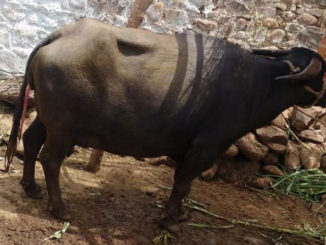Introduction
Oestrus ovis is a cosmopolitan parasite of sheep and goat and are commonly called as sheep nasal fly, nasal bot fly, sheep head fly and sheep gad fly. The fly is coming under (Order –Diptera, Family-oestridae), has a relatively short free living life cycle outside the host, and therefore it is important to know when the parasitic period occurs, in order to prevent the clinical signs and economical losses caused by the parasite. The larvae of the fly is a protelean parasite , inhabits the nasal passages and sinuses of sheep and goat. Humans acting as a accidental intermediate host, the larvae of the O. ovis causes External Opthalmomyiasis, an unawared zoonotic threat in humans. This condition is more common in shepherds and veterinarian because of their work nature. It is important to understand the life cycle and transmission in humans, because of its zoonotic importance.
Key Factor for fly identification
Adult fly
- Tarry spots are seen on the thorax
- Few black coloured spots are on the abdomen
- The adult stages are not parasitic
Larvae
Three larval stages, the mature third stage larvae is large, with black oral hooks , dark black bands on all the segments on the dorsal aspect. The posterior spiracles are brown, D shaped with radiating stigma slits. The larval stages are parasitic, seen in the nasal cavity and other sinuses of sheep and goat.


Life cycle and Transmission
The flies are larviparous, deposits about 200-500 larvae around the nostrils of the sheep. The first stage larvae then crawls to the nasal passage . The larvae moves within, using its oral hooks and feeds on the nasal discharge produced by the sheep. Development of first instar varies , may take 2 weeks or many months. The larvae moults to form the second stage larvae, which moves into the frontal sinuses and they develop rapidly and form the third stage of larvae. The mature third stage larvae is sneezed and the pupation occurs on the ground. The larval developmental time may vary from weeks to several months depends on the favourable conditions of the environment. The adult fly emerges in a month time from the third stage larvae. Humans gets the infection by close contact with the animal, when the flies moves around.
Effect on sheep and goat
Due to adult fly
The adult fly causes gadding in animals, and the animals stops feeding, become restless, shake their heads or even press their noses to the ground or between other sheep in an attempt to avoid the fly from larvipositing. Because of reduced feed intake , the body condition of the animals deteriorate.
Due to Larval stages
The first stage larvae moves around the nasal passage causing considerable irritation with its oral hooks and spines, results in the secretion of a viscid mucous exudate on which the larvae feeds. The infected animal shakes its head and sneezes frequently.
Snotty nose
Nasal region of the affected sheep is dirty in condition
Sometimes the second stage larvae moves accidentally towards the brain causing injuring to the brain, and even erosion of the skull which leads to neurological symptoms in sheep, resembles the condition of coenurus cerebralis . Hence the condition is called as False gid or Sturdy .
Zoonotic Importance
External ophthalmomyiasis is a bengin zoonotic condition, caused by the larvae of O.ovis. The adult fly accidentally deposits the larvae of O.ovis in the eyes, lips , nostrils and gums of the humans mostly in shepherds, farmers and veterinarians who are in close contact with the animals. The clinical signs includes redness of the eye (Red eye), burning, itching and tearing . In extreme cases the larvae may penetrate the sinuses, causing retinal damage and blindness (Sukumaran and Rajiv et al., 2008). This condition is worldwide wide in distribution. Several cases has been reported in humans around the world. Large group of livestock, into close contact with a dense population may leads to the risk for transmission of zoonoses.
Conclusion
From a cultural and economic point of view, public health awareness among the shepherds, farmers and veterinarian is important. Public health awareness campaigns are the need of an hour.
Reference
- Helminths, Arthropods and Protozoa of domestic animals by E. J. L. Soulsby ( 7th edition) .
- Sreejith, R.S., Reddy, A.K., Ganeshpuri, S.S.and Garg , P. 2010. Oestrus ovis Ophthalmomyiasis with keratitis. Indian J. Med. Microbiol. 28: 399 .
- Sukumaran, R .and Rajiv, J. 2008. Ocular Myiasis – A Case Report . Kerala journal of Ophthalmology volume xx .
- MSD veterinary manual.






Be the first to comment